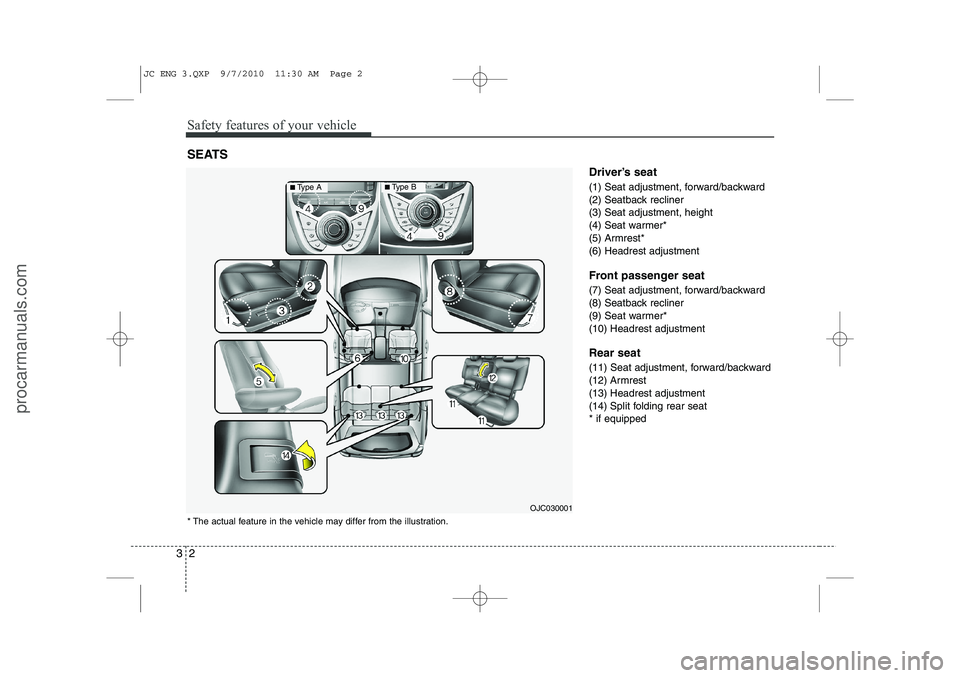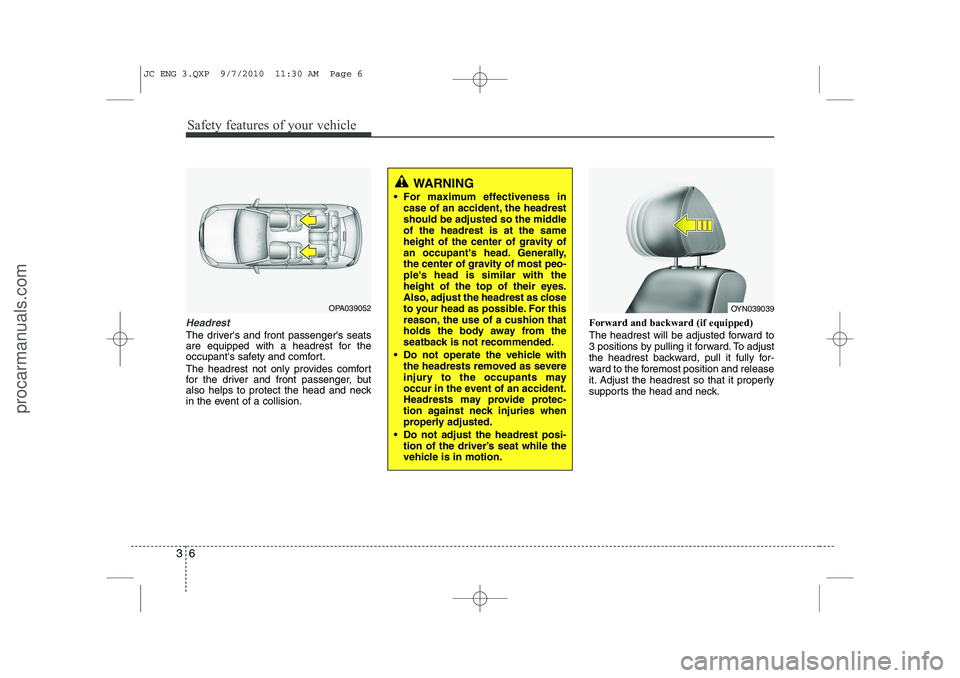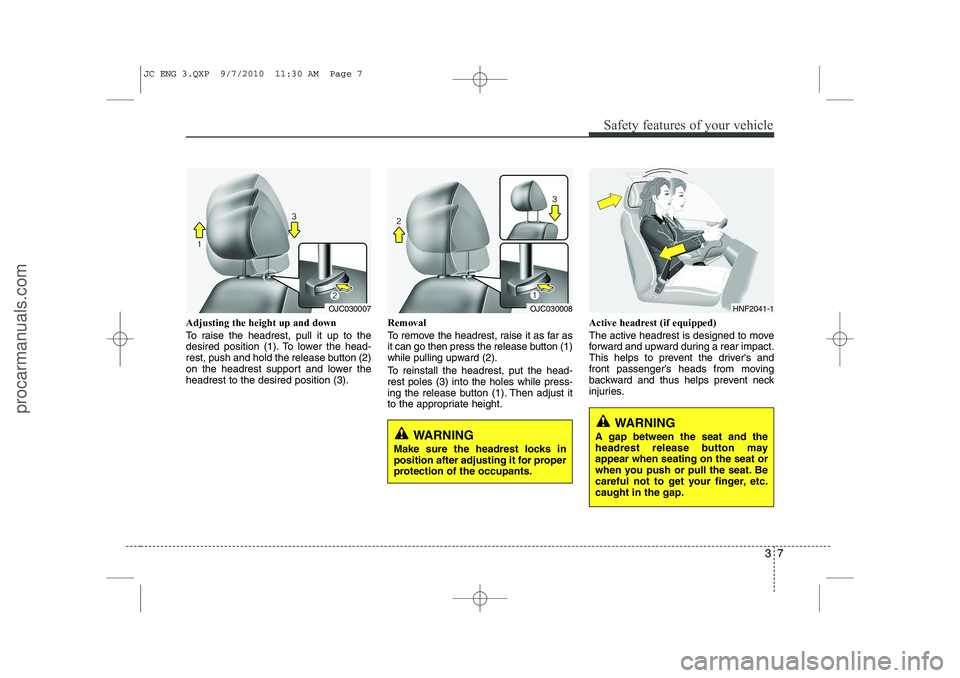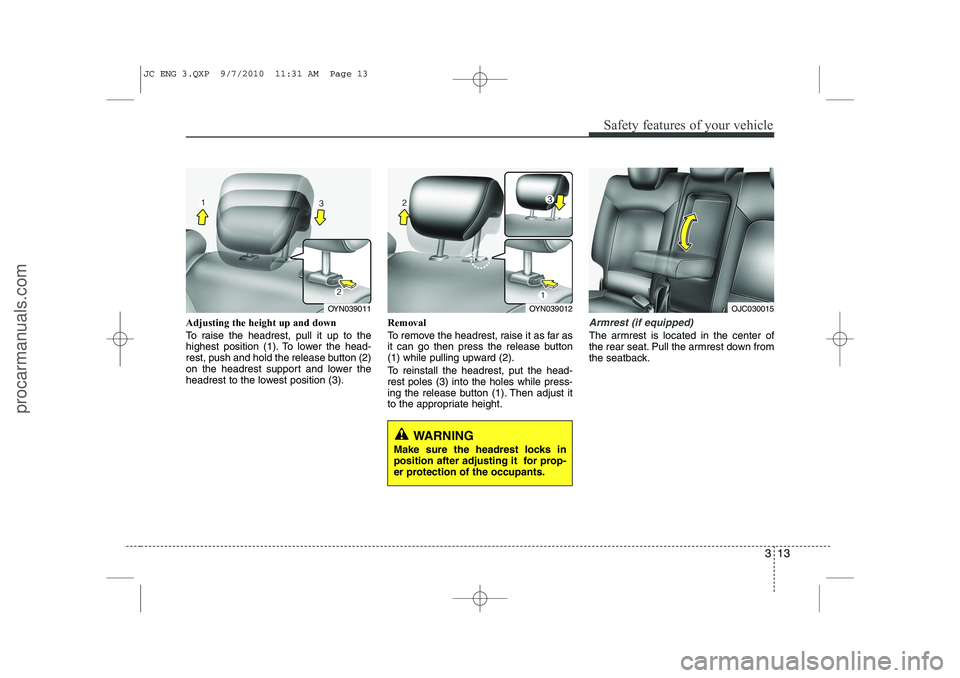2011 HYUNDAI IX20 headrest
[x] Cancel search: headrestPage 21 of 420

Safety features of your vehicle
2
3
Driver’s seat
(1) Seat adjustment, forward/backward
(2) Seatback recliner
(3) Seat adjustment, height
(4) Seat warmer*
(5) Armrest*
(6) Headrest adjustment
Front passenger seat
(7) Seat adjustment, forward/backward
(8) Seatback recliner
(9) Seat warmer*
(10) Headrest adjustment Rear seat
(11) Seat adjustment, forward/backward
(12) Armrest
(13) Headrest adjustment
(14) Split folding rear seat* if equipped
SEATS
OJC030001
* The actual feature in the vehicle may differ from the illustration.
■ Type A■ Type B
JC ENG 3.QXP 9/7/2010 11:30 AM Page 2
procarmanuals.com
Page 25 of 420

Safety features of your vehicle
6
3
Headrest
The driver's and front passenger's seats
are equipped with a headrest for the
occupant's safety and comfort.
The headrest not only provides comfort
for the driver and front passenger, but
also helps to protect the head and neck
in the event of a collision. Forward and backward (if equipped)
The headrest will be adjusted forward to
3 positions by pulling it forward. To adjust
the headrest backward, pull it fully for-
ward to the foremost position and release
it. Adjust the headrest so that it properly
supports the head and neck.
WARNING
For maximum effectiveness in case of an accident, the headrest
should be adjusted so the middleof the headrest is at the same
height of the center of gravity of
an occupant's head. Generally,
the center of gravity of most peo-ple's head is similar with the
height of the top of their eyes.
Also, adjust the headrest as close
to your head as possible. For this
reason, the use of a cushion that
holds the body away from the
seatback is not recommended.
Do not operate the vehicle with the headrests removed as severe
injury to the occupants may
occur in the event of an accident.
Headrests may provide protec-
tion against neck injuries when
properly adjusted.
Do not adjust the headrest posi- tion of the driver’s seat while the
vehicle is in motion.
OPA039052OYN039039
JC ENG 3.QXP 9/7/2010 11:30 AM Page 6
procarmanuals.com
Page 26 of 420

37
Safety features of your vehicle
Adjusting the height up and down
To raise the headrest, pull it up to the
desired position (1). To lower the head-
rest, push and hold the release button (2)
on the headrest support and lower theheadrest to the desired position (3).Removal
To remove the headrest, raise it as far as
it can go then press the release button (1)
while pulling upward (2).
To reinstall the headrest, put the head- rest poles (3) into the holes while press-
ing the release button (1). Then adjust it
to the appropriate height.Active headrest (if equipped)
The active headrest is designed to move
forward and upward during a rear impact.
This helps to prevent the driver's and
front passenger’s heads from moving
backward and thus helps prevent neck
injuries.
HNF2041-1
WARNING
Make sure the headrest locks in
position after adjusting it for proper
protection of the occupants.
WARNING
A gap between the seat and the
headrest release button mayappear when seating on the seat or
when you push or pull the seat. Be
careful not to get your finger, etc.caught in the gap.
OJC030007OJC030008
JC ENG 3.QXP 9/7/2010 11:30 AM Page 7
procarmanuals.com
Page 29 of 420

Safety features of your vehicle
10
3
Seatback angle
To recline the seatback:
1. Pull up the seatback recline lever.
2. Hold the lever and adjust the seatback
of the seat to the position you desire.
3. Release the lever and make sure the seatback is locked in place. (The lever
MUST return to its original position for
the seatback to lock.)
Folding the rear seat
The rear seatbacks may be folded to
facilitate carrying long items or toincrease the luggage capacity of the
vehicle.
To fold the rear seat
1. Insert the rear seat belt buckle in thepocket between the rear seatback and
cushion, and insert the rear seat belt in
the guide to prevent the seat belt frombeing damaged.
2. Set the front seatback to the upright position and if necessary, slide the
front seat forward and the rear seat
rearward.
3. Lower the rear headrests to lowest position.
WARNING
The purpose of the fold-down rear
seatbacks is to allow you to carry
longer objects than could not oth-erwise be accommodated.
Never allow passengers to sit on
top of the folded down seatback
while the car is moving as this is
not a proper seating position and
no seat belts are available for use.
This could result in serious injuryor death in case of an accident or
sudden stop. Objects carried on the
folded down seatback should not
extend higher than the top of the
front seats. This could allow cargo
to slide forward and cause injury or
damage during sudden stops.
OJC030035OJC030013
JC ENG 3.QXP 9/7/2010 11:31 AM Page 10
procarmanuals.com
Page 31 of 420

Safety features of your vehicle
12
3
Headrest
The rear seat(s) is equipped with head-
rests in all the seating positions for the
occupant's safety and comfort.
The headrest not only provides comfort
for passengers, but also helps to protect
the head and neck in the event of a colli-sion.
OPA039053
WARNING
For maximum effectiveness in case of an accident, the headrest
should be adjusted so the middleof the headrest is at the same
height of the center of gravity of
an occupant's head. Generally,
the center of gravity of most peo-ple's head is similar with the
height of the top of their eyes.
Also adjust the headrest as close
to your head as possible. The use
of a cushion that holds the body
away from the seatback is notrecommended.
Do not operate the vehicle with the headrests removed as severe
injury to an occupant may occur
in the event of an accident.
Headrests may provide protec-
tion against severe neck injuries
when properly adjusted.
WARNING - Cargo loading
Make sure the engine is off, the
automatic transaxle is in P (Park)and the parking brake is applied
whenever loading or unloading
cargo. Failure to take these steps
may allow the vehicle to move if
shift lever is inadvertently moved toanother position.
WARNING - Cargo
Cargo should always be secured to
prevent it from being thrown about
the vehicle in a collision and caus-
ing injury to the vehicle occupants.Special care of objects should betaken when placing them in the rear
seats, since those may hit the front
seat occupants in a frontal colli-sion.
JC ENG 3.QXP 9/7/2010 11:31 AM Page 12
procarmanuals.com
Page 32 of 420

313
Safety features of your vehicle
Adjusting the height up and down
To raise the headrest, pull it up to the
highest position (1). To lower the head-
rest, push and hold the release button (2)
on the headrest support and lower the
headrest to the lowest position (3).Removal
To remove the headrest, raise it as far as
it can go then press the release button
(1) while pulling upward (2).
To reinstall the headrest, put the head- rest poles (3) into the holes while press-
ing the release button (1). Then adjust it
to the appropriate height.Armrest (if equipped)
The armrest is located in the center of
the rear seat. Pull the armrest down from
the seatback.
OYN039012
WARNING
Make sure the headrest locks in
position after adjusting it for prop-
er protection of the occupants.
OJC030015OYN039011
JC ENG 3.QXP 9/7/2010 11:31 AM Page 13
procarmanuals.com
Page 51 of 420

Safety features of your vehicle
32
3
Securing a child restraint seat with
“Tether Anchor” system
Child restraint hook holders are located
on the floor behind the rear seats. 1. Route the child restraint seat strap
over the seatback.
For vehicles with adjustable headrest,
route the tether strap under the head-
rest and between the headrest posts,
otherwise route the tether strap over
the top of the seatback.
2. If your vehicle is equipped with a lug- gage board, set the board to the low-est position.
3. Open the tether anchor cover.
4. Connect the tether strap hook to the appropriate child restraint hook holder and tighten to secure the seat.
WARNING - Tether strap
Never mount more than one child restraint to a single tether or to a
single lower anchorage point. The
increased load caused by multiple
seats may cause the tethers or
anchorage points to break, causing
serious injury or death.
WARNING
A child can be seriously injured or
killed in a collision if the child
restraint is not properly anchored
to the car and the child is not prop-
erly restrained in the child restraint.
Always follow the child seat manu-
facturer’s instructions for installa-
tion and use.
OJC030021OYN039020
JC ENG 3.QXP 9/7/2010 11:32 AM Page 32
procarmanuals.com
Page 414 of 420

I5
Index
Front seat adjustment ························································3-4
Fuel filler lid ··································································4-26
Fuel filter(for diesel) ······················································7-42
Fuel gauge ······································································4-43
Fuel requirements ····························································1-3Fuses ··············································································7-60
Fuse/relay panel description ····································7-64
Main fuse ··································································7-63
Memory fuse ·····························································7-62
Multi fuse ·································································7-60
Gauges·············································································4-41 Engine temperature gauge·········································4-42
Fuel gauge ································································4-43
Glassroof, see panorama sunroof····································4-29
Glove box ·····································································4-100
Glove box cooling·························································4-101 Hazard warning flasher ··········································4-68, 6-2
Hazardous driving conditions ········································5-45
Headlight bulb replacement ···········································7-72
Headlight escort function ···············································4-69
Headlight leveling device ··············································4-74
Headrest ··································································3-6, 3-12
Heating and air conditioning ·········································4-82High mounted stop light replacement ····························7-77
Highway driving ····························································5-49
Hill-start assist control (HAC)········································5-34Hood ···············································································4-24Horn ···············································································4-34
How to use this manual ···················································1-2
Immobilizer system ·························································4-3
Indicators and warnings ·················································4-47Indicator symbols on the instrument cluster ····················1-7
Instrument cluster ··························································4-40
Engine temperature gauge ········································4-42
Fuel gauge ································································4-43
Instrument panel illumination ··································4-41
LCD display ······························································4-58Odometer ··································································4-43Speedometer ·····························································4-41
G
H
I
JC ENG INDEX.QXP 9/7/2010 12:36 PM Page 5
procarmanuals.com